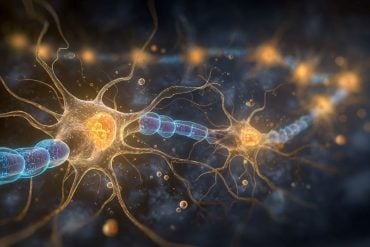Summary: New gene therapy may help those with achromatopsia, or complete color blindness, to improve visual function. The treatment targets the CNGA3 gene, which is implicated in one-third of achromatopsia cases.
Source: LUM
An initial trial in patients indicates that a new genetic treatment for complete color blindness, developed by research groups based in Tübingen and Munich is safe. Preliminary evidence for its efficacy has also been obtained.
People who are born with complete color blindness are unable to distinguish colors. Their vision is blurred and their eyes are highly sensitive to bright light. This is due to a defect in the cone cells—the light receptors in the retina that are responsible for daylight and color vision. Complete color blindness, or achromatopsia, affects around 3,000 people in Germany. As yet, there is no treatment for the underlying cause.
In about one-third of all achromatopsia patients, the defect lies in the CNGA3 gene. A team from the Institute for Ophthalmic Research at the University Hospitals in Tübingen and the Departments of Pharmacy and Ophthalmology at LMU has developed a treatment that should, in principle, correct this genetic defect. It involves introducing the normal version of the CNGA3 gene directly into the patient’s retina with the aid of a harmless virus. After a few weeks, the retinal cells can express this functional version of the CNGA3 gene and are able to produce the intact form of the corresponding protein, which should restore the function of the defective cones. In this case, the healthy gene is transported by an adeno-associated virus developed by Professors Stylianos Michalakis and Martin Biel at LMU.
The first clinical study of this approach in patients has just been completed at the University Eye Hospital Tübingen. The results appear in the journal JAMA Ophthalmology. In the study, nine achromatopsia patients aged between 24 and 59 years were treated by injection of the virus bearing the intact CNGA3 gene into retina of the more severely affected eye. “The experimental subjects suffered no drug-related health problems as a result, nor did their retinas show any permanent changes,” says Professor Dominik Fischer, who headed the clinical study. He said the main objective of this first clinical study had been achieved—the treatment can be classified as safe. There was also a clear positive effect in terms of efficacy. The patients’ visual function has improved somewhat, both in terms of focus and in relation to contrast and color vision.

“The study is an important first step. It represents a milestone on the road to a curative therapy of achromatopsia, and we expect even better treatment success in the future,” said Professor Bernd Wissinger from the Tübingen Research Center for Ophthalmology who, together with Martin Biel from the Department of Pharmacy at LMU, leads the RD-CURE project, which is developing genetic treatments for a number of hereditary retinal diseases.
For safety reasons, the nine patients chosen were all adults—and their retinas had already been damaged to varying degrees. “Furthermore, the parts of the brain that process vision increasingly lose plasticity in adulthood,” emphasizes Professor Marius Ueffing, Director of the Institute for Ophthalmic Research in Tübingen. “Since the brains of people with achromatopsia have never learned to process color information, they need at least some plasticity to translate the retina’s newly acquired ability to respond to colors into a real visual impression.” Now that the study has shown that the treatment is safe, it may be feasible in the future to treat patients early enough to take advantage of higher brain plasticity and retinal tissue that has not yet suffered much damage to increase the success of the treatment.
The researchers say the new treatment should therefore be carried out in childhood, as in the case of the recently approved genetic therapy drug Luxturna, in order to achieve the best possible effect. “Since the gene vectors used have proven to be safe, a follow-up study in pediatric CNGA3 patients is possible and useful,” says Stylianos Michalakis from the Department of Ophthalmology at LMU.
About this neuroscience research article
Source:
LUM
Media Contacts:
Press Office – LUM
Image Source:
The image is credited to Stylianos Michalakis.
Original Research: Open access
“Safety and Vision Outcomes of Subretinal Gene Therapy Targeting Cone Photoreceptors in Achromatopsia”. by M. Dominik Fischer et al.
JAMA Ophthalmology doi:10.1001/jamaophthalmol.2020.1032
Abstract
Safety and Vision Outcomes of Subretinal Gene Therapy Targeting Cone Photoreceptors in Achromatopsia
Importance
Achromatopsia linked to variations in the CNGA3 gene is associated with day blindness, poor visual acuity, photophobia, and involuntary eye movements owing to lack of cone photoreceptor function. No treatment is currently available.
Objective
To assess safety and vision outcomes of supplemental gene therapy with adeno-associated virus (AAV) encoding CNGA3 (AAV8.CNGA3) in patients with CNGA3-linked achromatopsia.
Design, Setting, and Participants
This open-label, exploratory nonrandomized controlled trial tested safety and vision outcomes of gene therapy vector AAV8.CNGA3 administered by subretinal injection at a single center. Nine patients (3 per dose group) with a clinical diagnosis of achromatopsia and confirmed biallelic disease-linked variants in CNGA3 were enrolled between November 5, 2015, and September 22, 2016. Data analysis was performed from June 6, 2017, to March 12, 2018.
Intervention
Patients received a single unilateral injection of 1.0 × 1010, 5.0 × 1010, or 1.0 × 1011 total vector genomes of AAV8.CNGA3 and were followed up for a period of 12 months (November 11, 2015, to October 10, 2017).
Main Outcomes and Measures
Safety as the primary end point was assessed by clinical examination of ocular inflammation. Systemic safety was assessed by vital signs, routine clinical chemistry testing, and full and differential blood cell counts. Secondary outcomes were change in visual function from baseline in terms of spatial and temporal resolution and chromatic, luminance, and contrast sensitivity throughout a period of 12 months after treatment.
Results
Nine patients (mean [SD] age, 39.6 [11.9] years; age range, 24-59 years; 8 [89%] male) were included in the study. Baseline visual acuity letter score (approximate Snellen equivalent) ranged from 34 (20/200) to 49 (20/100), whereas baseline contrast sensitivity log scores ranged from 0.1 to 0.9. All 9 patients underwent surgery and subretinal injection of AAV8.CNGA3 without complications. No substantial safety problems were observed during the 12-month follow-up period. Despite the congenital deprivation of cone photoreceptor–mediated vision in achromatopsia, all 9 treated eyes demonstrated some level of improvement in secondary end points regarding cone function, including mean change in visual acuity of 2.9 letters (95% CI, 1.65-4.13; P = .006, 2-sided t test paired samples). Contrast sensitivity improved by a mean of 0.33 log (95% CI, 0.14-0.51 log; P = .003, 2-sided t test paired samples).
Conclusions and Relevance
Subretinal gene therapy with AAV8.CNGA3 was not associated with substantial safety problems and was associated with cone photoreceptor activation in adult patients, as reflected by visual acuity and contrast sensitivity gains.
Trial Registration
ClinicalTrials.gov Identifier: NCT02610582
Feel Free To Share This Neuroscience News.






